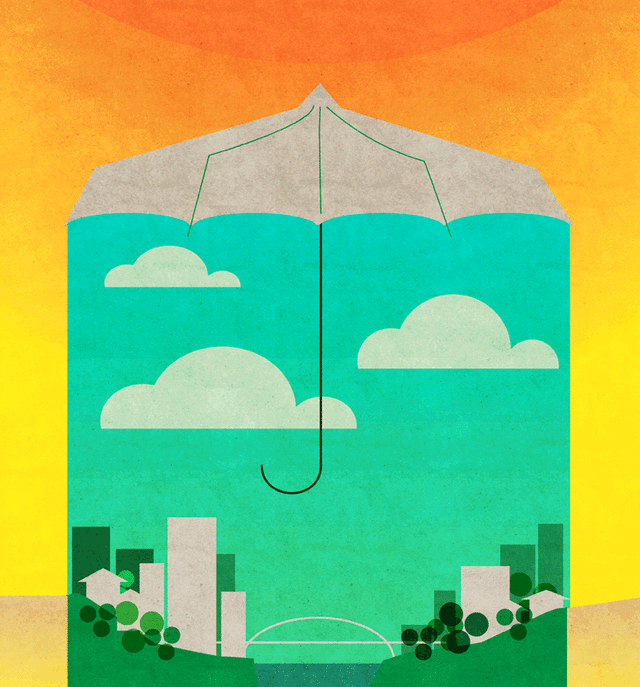How Will Portland Fare in a Future of Climate Change?

Image: Amy Martin
When Hollywood location scouts came to Oregon in 2008 for the movie version of Cormac McCarthy’s postapocalyptic novel The Road, they used familiar Northwest backdrops to create dystopia: drizzling rain, barren trees, gunmetal skies, thick layers of dead leaves, and wild, unkempt beards.
Real-world climate change offers a duller vision of doom. Instead of The Road’s roving cannibals, global warming’s story involves conferences, papers, and stubborn politicians, with few interesting plot twists. Last September’s UN Climate Summit in New York attracted leaders, poets, and Leonardo DiCaprio, but accomplished little. When the US and China announced a major climate agreement in November, it was notable for being a rare breakthrough in an interminable international stalemate. In Oregon, Gov. John Kitzhaber’s 10-Year Energy Action Plan—which, in 2012, called for voluntary carbon reductions, energy efficiency standards, and investment in technology like wave energy—is largely still just a plan.
Meanwhile, however, Oregon’s local governments are already preparing for a warmer world. At the coast, groups like Envision in Tillamook County are developing construction and land-use policies to anticipate sea levels rising by up to a meter by 2100. In Portland, planners have developed a Climate Change Preparation Strategy that blueprints action to fight warming’s effects, like increasing vegetation to reduce urban heat, using porous pavement, and relocating infrastructure from flood zones.
“Climate is local,” says Susan Anderson, the director of the city’s Bureau of Planning and Sustainability. “Even though some impacts of the weather are kind of similar between Seattle and Portland, for instance, we have really different issues.”
Climate change is happening, no matter how many Priuses we drive or locally grown carrots we consume. The best-case scenario, according to a new study from the Oregon Climate Change Research Institute: India, China, and the US get real, and global carbon emissions stabilize within the next 20 years. By 2070, Oregon would still be much warmer—up to 8.5 degrees Fahrenheit, on average. (The state is now only 1.3 degrees warmer than a hundred years ago.) Annual precipitation will remain roughly the same, but summers will be drier and every other season will be wetter.
In fact, Portland’s rainy outlook puts the city in a distinct, possibly advantageous position. Soggy winters will balance out summer heat and ensure us potable water. Bull Run, the city’s aboveground reservoir, is primarily rain-fed, and doesn’t depend on snowpack like water sources in much of drought-stricken California. The system also has a backup: an underground aquifer that can be tapped in dry months. Our proximity to rivers and the ocean will curb extreme heat; some local agriculture, while it may strain our water supply, will enjoy a longer growing season. And for now, there is no nonanecdotal evidence that climate refugees will overwhelm us.
While local work on emissions and efficiency continues (the city will soon update its 2009 Climate Action Plan, an ambitious road map to cutting local emissions 80 percent by 2050), Portland officials are also creating zoning buffers around high-risk wildfire and landslide zones. (“We have all this glacial silt sitting on bedrock,” explains Portland State geology professor Andrew Fountain. “When you get a lot of rain, it forms a wonderful slippery surface.”) The city is shoring up stormwater lines at risk for flooding, and creating new land-use guidelines for areas in the floodplain. Using new kinds of concrete, depaving certain areas of the city, and increasing tree canopies and eco-roofs will help reduce the “heat island” effect of urban asphalt, concrete, and masonry. The strategy also includes combating human health risks associated with extreme temperatures: controlling disease-bearing rats and insects, for instance, and planning additional emergency services during periods of high heat and humidity.
“I am optimistic that the level of awareness has improved over the last six to eight years,” says Jeff Weber, conservation coordinator for the Oregon Coastal Management Program. “But it may require some hazard event to bring the issue front and center, like a wildfire or a flood or a large winter storm. That’s just the nature of the beast.”
Of course, planning for the future has its limits. No one knows exactly how bad it will get. That depends on how the world, as a whole, deals with carbon emissions.
“There are a variety of intentions and actual actions that could stabilize the climate,” says Philip Mote, atmospheric sciences professor at Oregon State and director of the OCCRI. “But if we go pell-mell and China and India do the same, then we are looking at somewhere between 7- and 14-degree warming in the Northwest by the end of the century. That would be a world that is quite, quite different.”
In other words, we’re already on the road. For now, we can still try to steer a smart course.
